
views
Exercising to Build up Your Glutes
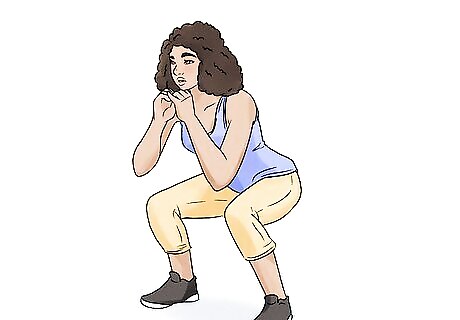
Do squats to build muscle and tone your buttocks. To squat, stand with your feet shoulder width apart and bend you knees and hinge forward at the hips as if you’re going to sit down. Keep going until your thighs are almost parallel to the ground, then slowly rise back up to your starting position. Repeat this 15 to 20 times to complete 1 set. Do 2 to 3 sets of squats into each of your twice weekly strength training sessions. Hold a dumbbell in each hand while you squat to make the move harder. Add a jump at the end of your squats to increase the intensity. Try plie squats or side squats for another variation on the basic squat.
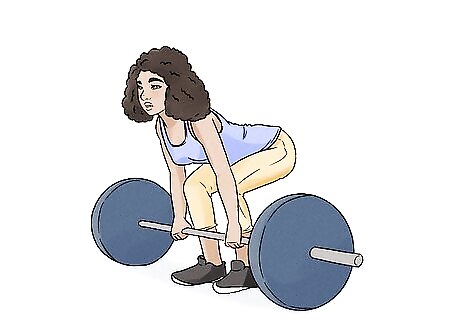
Do deadlifts to work your glutes, hamstrings, and back. Start by using an unweighted barbell. Stand with your feet beneath the barbell shoulder-width apart so that the balls of your feet are directly under the bar. Bend forward at your hips and grasp the bar with your hands. Then slowly rise back up to a standing position with the barbell in your hands. Bend forward again to place the barbell back on the ground, and repeat. Do 8 to 10 repetitions for a set. Include 2 to 3 sets in each of your twice weekly strength training sessions. If you add weight to the barbell, be careful not to add too much weight until you get the form of this exercise correct. For example, you might start by adding 5 lb (2.3 kg) and see how you do with that before adding any more.

Do front lunges to work your glutes, hamstrings, and legs. To do a front lunge, step forward with your right foot and bend your right knee until your thigh and calf are at a 90-degree angle. Don't allow your right knee to extend beyond your toes. Push off of your front foot to return to a standing position. As you rise up, tighten your glutes, your thigh muscles and your calf muscles to bring yourself back to the starting position in a slow and controlled manner. You can either repeat the lunges on your right side or you can step forward with your left foot and lunge, continuing to alternate sides. Do 2 to 3 sets of 8 so that you perform 8 lunges on the right side and 8 lunges on the left side. Include front lunges in your twice weekly strength-training sessions.
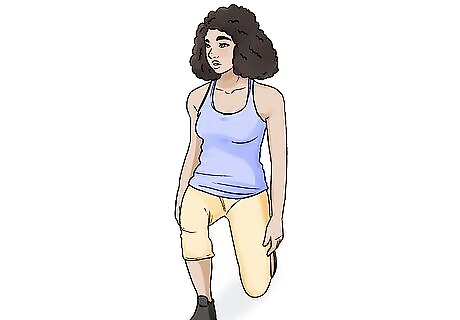
Try reverse lunges to work your glutes, hamstrings, and legs. To do a reverse lunge, place your left leg a step behind you. Lower your hips until your left calf is parallel to the floor and your right knee is bent at a 90-degree angle. Push off of your right foot and raise yourself up. Keep your back aligned with your hips, and use your glutes, quads, hamstrings and calves to push yourself upward. Bring your left foot back to the starting position. Extend your right foot backward and repeat the reverse lunge on your right side. Do 2 to 3 sets of 8 reps so that you get 8 reps for each side of your body. Include reverse lunges into each of your 2 weekly strength-training sessions.
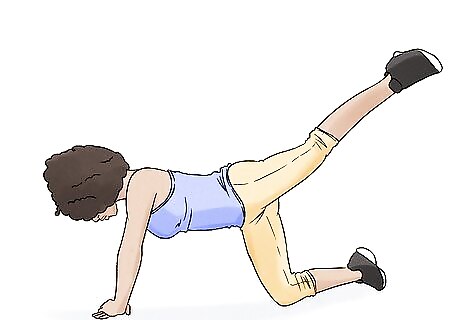
Add glute kickbacks to isolate your glutes. Get down on your hands and knees as if you’re going to crawl. Then, lift your right foot up towards the ceiling. You should feel the squeeze in the right side of your butt. Hold the lift for 5 seconds before lowering your foot back to its starting position. Do this 12 to 15 times for 1 set. Then, repeat the same exercise on your left side. Do 2 to 3 sets on each leg. Increase the challenge as you go by holding your kickback for longer or by doing more reps. You can also try weighted cable kickbacks to add more resistance as you gain strength.

Try hip bridges to work your glutes, core, and hamstrings. Lie down on the floor on your back with your arms at your sides, your knees bent, and your feet flat on the ground. Then, lift your hips and buttocks off the ground until your body is in a straight line from your shoulders to your knees. Hold the position for 5 seconds, then lower yourself back down to the ground. Repeat this 8 to 12 times to complete 1 set. Do 2 to 3 sets in each of your twice weekly strength-training sessions. To make the move more challenging, lift 1 foot off the ground and straighten your leg. Do 1 set on this side and then switch legs to work both side of your glutes equally. Another option is to hold a dumbbell across your hips while you do the lifts. This will also add extra resistance.

Do fire hydrants to work the sides of your glutes. Start by getting down on all fours, preferably on a yoga mat or other comfortable surface. Keep your knee bent at a 90 degree angle and lift one leg outwards to the side so that the side of your leg is parallel to the floor. Hold for 2 seconds, and then lower your leg back down to the starting position. Do 2 to 3 sets of 15 to 20 reps on each side. Make the move more challenging by holding your leg up for longer and increasing the number of reps.
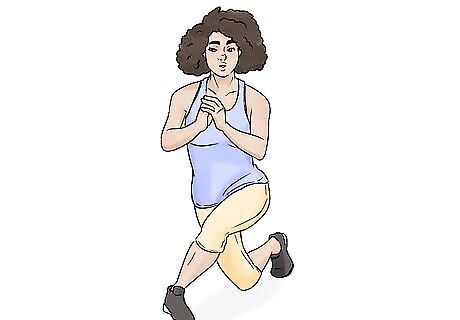
Try skater lunges. Skater lunges work your glutes, plus a number of other muscles in your legs. Start by standing with your feet shoulder-width apart. With your left leg, step diagonally behind your right, and lower yourself into a lunge so that your knee almost touches the floor. Then, return to your starting position. Repeat the movement with your right leg, stepping diagonally behind your left. Do 2 to 3 sets of 15 to 20 reps on each side. If you want to increase the intensity, hold a weight in each hand while you do the exercise. Tip: Muscles need time to repair, literally, the rips and tears that occur with extensive exercise. You may think going, going, going will get you the fastest results, but your muscles will burn out. Always allow at least 1 rest day between your strength training sessions.
Dressing to Accentuate Your Butt
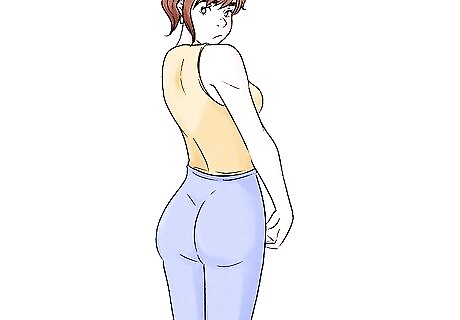
Cinch in your waistline or wear clothes that contour your hourglass figure. Anything that draws in at your smallest points is a safe bet. Avoid tops or dresses that cinch in just below your bra or that cinch around the hip as these will diminish the appearance of your butt. Place a dark-colored belt over any shirt or dress at your natural waistline to elongate the line of your body and draw the eye to your smallest section. Opt for high-waisted pants, shorts, skirts, and jeans. High-waisted items will accentuate the smallest part of your waist and make it look even smaller, which will make your butt look bigger. Tip: Steer clear of low-cut items like hip-hugger jeans, shorts, and skirts as these will make your waist seem larger and make your butt seem smaller by comparison.
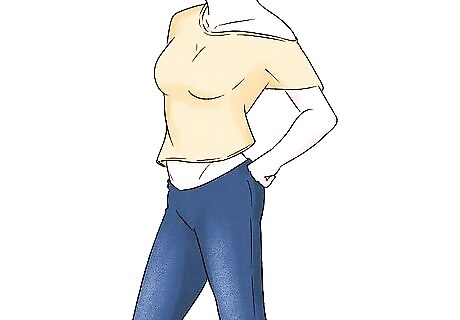
Look for items that use horizontal color blocking. Don’t wear vertical stripes on your bottom half as this design will make your backside appear smaller. Instead, wear items that have a horizontal divide between the waist and skirt or halfway down the skirt. This will help to accentuate your backside and make it appear larger. Also, consider pocket placement and color. Small, high back pockets and ones with eye-catching designs are great for giving the illusion of a bigger rear. Stay away from jeans with big pockets or no pockets at all.
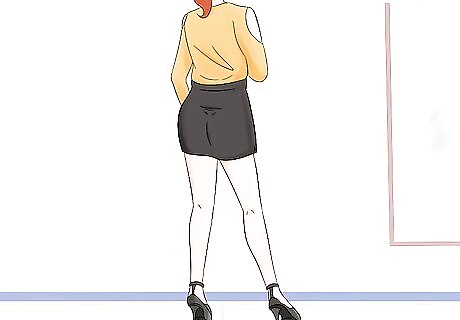
Pair short, fitted skirts with high heels. Heels will make you naturally tilt your pelvis forward, making your legs look longer and your butt look bigger. They also flex your calves, making your legs look more toned. Pairing heels with a short, fitted skirt will make your butt look even bigger. If you're uncomfortable in heels, start out with a kitten heel. No one will be looking at your butt (no matter how great it is) if you're constantly on the verge of falling over.
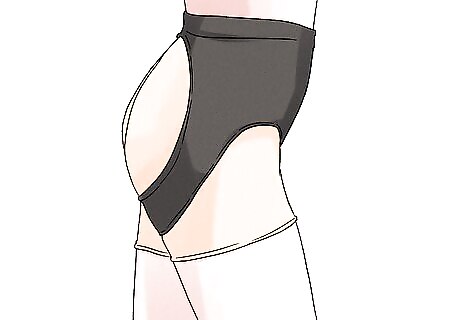
Wear padded panties under your clothing to add volume and curves. You can purchase special padded underwear online and in lingerie stores that are meant to make your butt look bigger. Wear them under your clothing like regular underwear. Padded panties come in different types and padding levels. Choose the level of padding that appeals to you.
Adjusting Your Eating Habits
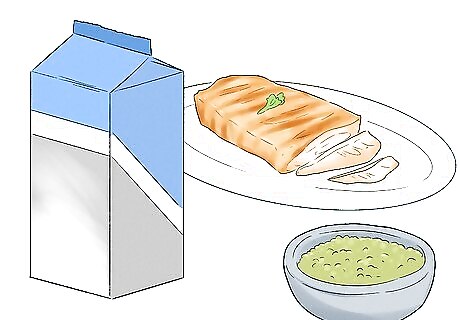
Incorporate 3 daily servings of protein-rich food in your diet. Protein is important for building muscle, but it’s important to avoid eating too much. You only need about 10 to 35% of your total daily calories to come from protein. Have a serving of a protein-rich food with each meal and you will get plenty. Some good choices include: 1/2 cup (120 g) of low-fat cottage cheese 3 oz (85 g) of skinless chicken breast, fish, lean beef, or ground turkey 1/2 cup (120 g) of beans or lentils 3 oz (85 g) of tofu 1 cup (240 g) of cooked quinoa 8 fl oz (240 mL) of low-fat milk
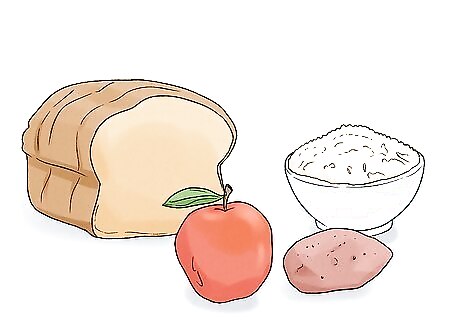
Ensure that 50% of your calories come from carbohydrates each day. Carbohydrates are essential for fueling your body during your workouts, so make sure that you eat 1 to 2 servings of carbohydrates with each meal. You can get carbohydrates from a variety of foods including whole grains, fruits, and vegetables. Some good choices include: Whole grain breads and cereals Brown rice Whole wheat pasta Oatmeal Sweet potatoes Fruits, such as apples, bananas, oranges, and melons

Eat healthy fats in moderation to provide fuel for your workouts. You don’t need a lot of fat in your diet and too much fat can be bad for you. However, eating about 20 to 35% of your calories from fat is a reasonable amount that may help to fuel your strength-training workouts. Opt for healthy, unsaturated fats instead of saturated and trans fats. Some good options include: Olive oil Canola oil Nuts, seeds, and nut butters Avocados Fatty fish, such as salmon and mackerel
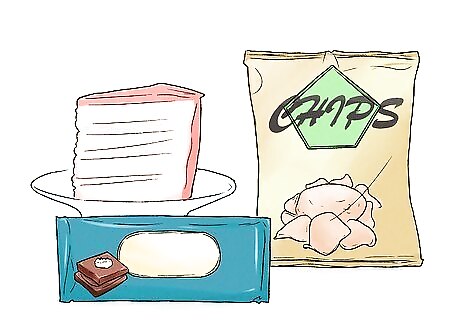
Adjust your caloric intake to lose weight or gain weight if needed. You may need to increase your daily caloric intake to gain weight if you’re underweight, or cut calories to lose weight if you’re overweight or obese. Being very thin means you won’t have as much body fat all over, so your butt is more likely to look flat. But being overweight means you’re more likely to have excess fat around your middle, which can make your butt look small by comparison. Talk with your doctor to determine if you might benefit from losing or gaining weight. Don’t try to lose or gain weight to affect the size of your butt if you’re at a healthy weight.Tip: Keep in mind that you cannot gain or lose weight in one specific area. If you lose weight, it’s going to come off your entire body. If you gain weight, it will be distributed over your whole body.
Trying Spa and Medical Treatments
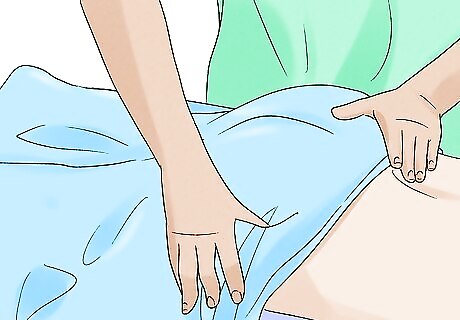
Get a massage to enhance the appearance of your butt. A gluteal massage may help to improve the appearance of your rear. Go for a full body massage and ask for them to pay attention to your gluteal muscles. Keep in mind that some massage therapists may not massage this area directly, but they may be willing to massage the areas around your buttocks. Be aware that a massage will not directly affect the size of your butt. It may make the skin glow and give the temporary illusion of tone, but your rear will not get magically bigger overnight.
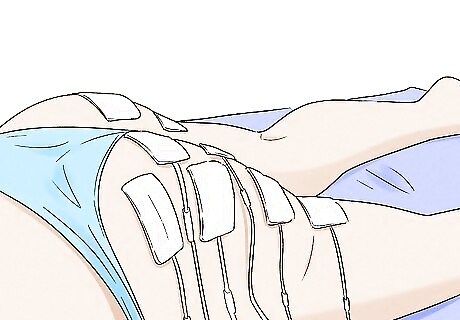
Try microcurrent treatments to make your butt look taut and toned. Check with your local spa or a dermatologist to see if they offer microcurrent buttock treatments. This is a method of stimulating the muscle fibers in your buttocks to make them appear more toned and taut. Getting a treatment done is roughly the equivalent of doing 360 squats. Keep in mind this treatment won’t make your butt bigger, but it may help it to appear firmer than before.
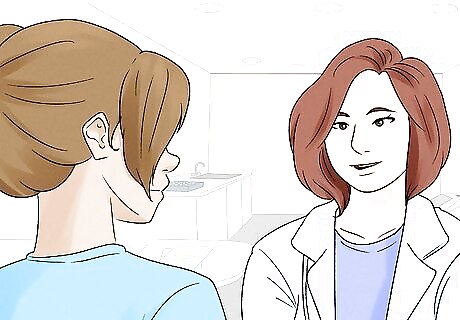
Meet with a board certified plastic surgeon to discuss surgical options. If you’re very unhappy with the appearance of your butt and you’ve tried everything to get it to the size you want, you might have reached limit of your genetics. Keep in mind that many celebrities have surgery to achieve a certain figure. If you’re striving for a specific look that you haven’t been able to achieve with exercise, diet, and clothing choices, find a board certified plastic surgeon to discuss treatment options. Keep in mind that plastic surgery is not covered by insurance and it can be quite expensive.Warning: Talk with a board certified plastic surgeon to ensure that you’ll be in the care of an experienced professional. Don’t opt for the cheapest option when considering plastic surgery as this may increase your risk of negative outcomes.

















Comments
0 comment